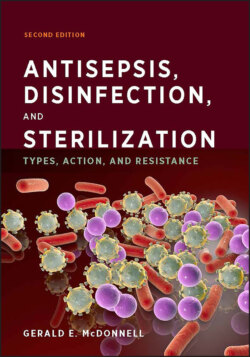Читать книгу Antisepsis, Disinfection, and Sterilization - Gerald E. McDonnell - Страница 28
1.4 GENERAL CONSIDERATIONS 1.4.1 Microbial Resistance
ОглавлениеDifferent types of microorganisms vary in their responses to antiseptics, disinfectants, and sterilants. This is hardly surprising, in view of their different cellular structures, compositions, and physiologies (see section 1.3). Traditionally, microbial susceptibilities to biocides have been classified based on these differences (Fig. 1.17). Bacterial spores are generally considered the organisms most resistant to antiseptics, disinfectants, and sterilants, although prions have shown marked resistance to many physical and chemical processes (see section 8.9). It is important to note that this classification is considered only a general guide to antimicrobial activity and can vary depending on the biocide, formulation, or process under consideration. For example, while the profile shown in Fig. 1.17 may be considered applicable to heat-based processes, some fungal spores can demonstrate greater resistance to non-ionizing-radiation methods, and some protozoan oocysts are relatively sensitive to heat but resistant to chemical sporicides. Some extremophiles can also show atypical patterns of resistance to various biocides (see section 8.3.10). The resistance of microorganisms to biocides is considered in more detail in chapter 8.
In addition, it is clear that the resistance of a microorganism also depends on direct contact with the biocide and is affected by many other associated variables, including the following:
The actual microbial strain and culture conditions for growth
The growth phase of the microbial culture (population and exponential-versus stationary-phase growth)
The type of associated surface and/or medium (water, plastic, metals, paper, etc.)
The presence of organic and/or inorganic soils
Presence within its normal environmental conditions, e.g., within a biofilm (see section 8.3.8)
A range of microorganisms can be chosen to establish the broad-spectrum activity of a product or process, depending on the required or desired application. For example, a sterilizing agent is expected to be effective against viruses, fungi, protozoa, mycobacteria, and other bacteria, including bacterial spores. Bacteria (including spores), fungi, mycobacteria, and to a lesser extent viruses are most commonly used as test microorganisms. Considering the multitude of microorganisms and applications, it is common to use surrogates as test organisms to establish the broad-spectrum efficacy of a product or its antimicrobial activity against a class of microorganisms (Table 1.17). Despite acceptance of these surrogates, in some cases the specific test organisms are used, or are required to be used, to verify the claimed antimicrobial activity.
